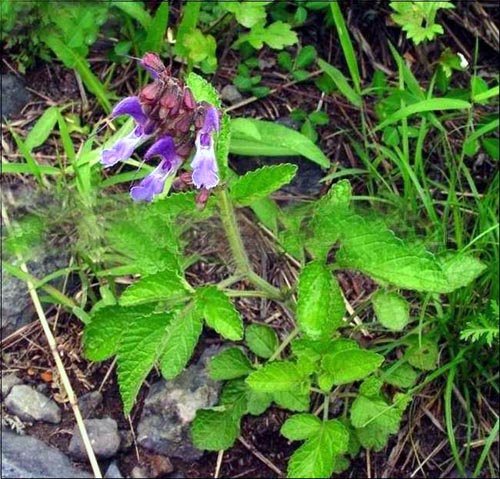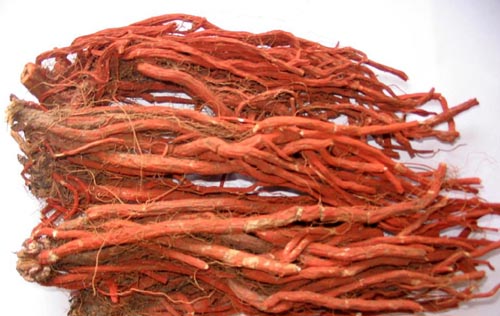The source is from the root and rhizome of Salvia miltiorrhiza Bunge, family Labiatae. The medicinal herb is produced in most parts of China, mainly in areas of Hebei, Anhui, Jiangsu, and Sichuan, etc. Dug and collected in spring and winter, dried in the sun and the crude or the stir-baked with wine is used.
Medicinal Properties:
Bitter in flavor, slightly cold in nature and attributive to the heart, pericardium and liver meridians.
Actions:
Promote blood circulation to remove blood stasis, regulate menstruation to relieve pain, cool the blood to relieve carbuncle, and clear away heat from the heart and tranquilize the mind.

Application
1. It is indicated for irregular menstruation, amenorrhea, postpartum abdominal pain resulting from blood stasis, abdominal masses and pain of limbs. Since it is cold in nature, it is especially suitable for syndrome of blood stasis with heat. It is also good at regulating menstruation, therefore it is an essential medicine in maternity department. For women's syndromes due to blood stasis, it is usually combined with Honghua (Flos Carthami), Taoren (Semen Persicae ), and Yimucao (Herba Leonuri), etc.; for the pains in the chest and epigastric abdomen resulting from blood stasis and stagnation of qi, combined with Tanxiang (Lignum Santali Albi ) and Sharen (Fructus Amomi), such as Danshen Yin (Decoction); for abdominal masses, combined with Sanleng (Rhizoma Sparganii ), Ezhu ( Rhizoma Zedoariae ), Zelan (Herba Lycopi), and Biejia ( Carapax Trionycis ), etc.; for trauma with pain due to blood stasis, usually combined with Danggui ( Radix Angelicae Sinensis ), Honghua ( Flos Carthami ) and Chuanxiong ( Rhizom Chuanxiong); for Bi-syndrome of wind-damp-heat type with red, swollen and painful joints, combined with Rendongteng ( Caulis Lonicerae ), Chishaoyao ( Radix Paeoniae Rubra ) and Qinjiao (Radix Gentianae Macrophyllae ).

2. For carbuncle with swelling and pain, it is combined with medicinal herbs that clear away heat and eliminate toxic materials, which can help relieve carbuncle. For example, for breast abscess with swelling and pain, combined with Ruxiang (Olibanum), Jinyinhua (Flos Lonicerae ) and Lianqiao ( Flos Forsythiae ), that is, Xiaoru Tang (Decoction).
3. It is used for febrile disease with restlessness, coma, palpitation and insomnia; for pathogenic factors invading yingfen and xuefen in the seasonal febrile disease, it is usually combined with Shengdihuang (Radix Rehmanniae), Xuanshen (Radix Scrophulariae), Zhuyexin (the centre of Folium Phyllostachydis Nigrae), such as Qingying Tang (Decoction); for palpitation and insomnia due to preponderant heart-fire or blood failing to nourish the heart, usually combined with Suanzaoren (Semen Ziziphi Spinosae ) and Baiziren ( Semen Biotae ).
But now, clinically, it is usually prepared into tablet or injection to treat epatosplenomegaly and anginal attack in coronary heart disease.
Usage and Dosage:
9 - 15 g is used in decoction for oral use. The stir-baked one with wine can strengthen the action of promoting blood circulation.
Notes:
It is incompatible with Lilu (Rhizoma et Radix Veratra ).







